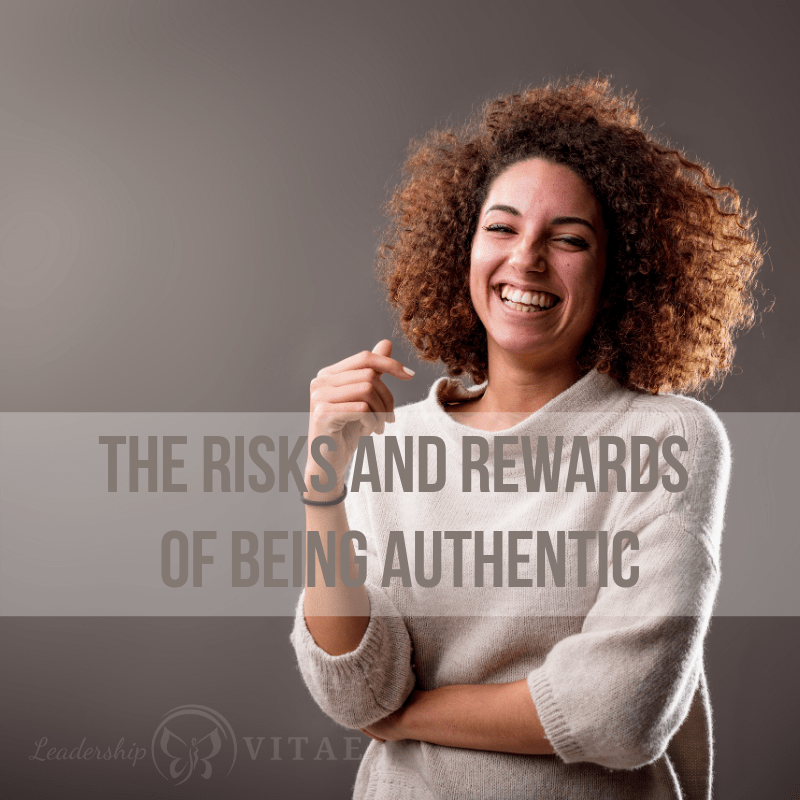
Lately, I’ve been seeing and hearing a lot about being authentic. While I love, and try to live, the sentiment, I believe most advice on the topic tends to be only part of the story. Particularly for women or under-represented communities.
Each time I hear about authenticity, I wait. Inevitably, what is shared revolves around showing up as your true self, using your voice, being heard, and bringing “all of you” to the table.
And that’s it.
I get fired up when the advice stops. It’s insufficient, incomplete, and potentially misleading.
This week in authenticity guidance
I recently attended a women’s conference and authenticity came up in every keynote and breakout. It’s the buzzword du jour.
In every single session, I heard about its importance. Either being authentic ourselves, or about leaders needing to create the space for others to show up authentically.
Carla Harris, who delivered a rousing keynote at the event, led with authenticity as the number one trait leaders should be intentional about if they want to be successful.
She said that, whatever role we are in, we were selected above someone else. So we should be that person and not waste intellectual capacity trying to be someone else.
In a subsequent session devoted to authenticity, the panelists gave some advice specific to women. They said to ask ourselves three questions:
- What stereotypes exist about women?
- Which ones might we be falling into?
- How do we honor ourselves while resisting those?
I loved those questions. They were the closest I’ve seen to advice on how to navigate authenticity and the pressures pushing against it. Yet then the advice pivoted to how leaders can help others show up authentically during the pandemic.
Incomplete advice
The sad reality is that there can be a penalty for being authentic.
There are professional and cultural norms everywhere we go. Showing up in a way that’s at odds with those norms may have negative consequences that outweigh the alternative.
It may feel better to “be ourselves.” However, that may not feel welcome. Particularly if a company culture tends to value and reward certain types of behaviors, while providing critical feedback on others.
Many companies are now celebrating diversity, including diversity of thought and communication style. In spite of those improvements, it may not always feel that diversion from the established cultural “norm” is embraced.
Reinvented or inauthentic?
Over the years, I’ve reinvented myself several times. I’d like to think that I’ve remained my authentic self at my core. However, how I show up has been influenced strongly by the environment I find myself in.
For example, originally I was an introverted thinker. I would create pictures in my mind of the problem at hand and then share my thoughts on solutions or next steps. My ideas and recommendations were challenging for others to follow when I’d share them. To address critical feedback, I began to externalize my thinking so others could connect the dots.
While that has been hugely helpful to connect with a broader audience, every organization has a different norm I’ve had to adjust to. Pivots I’ve made to make it easier to fit in based on feedback I’ve received that my “authentic self” could be better received “if only.”
The reality
Talking with others, this is far from uncommon. While there are men I know who have experienced pressure to adjust their style to fit in, I hear it a lot from women. So many have received feedback and pressure, whether subtle or more overt, to adjust and fit in.
One of my coworkers has a southern accent (we work in the south) and she’s been told it’s unprofessional. She has learned to modify her dialect to be seen as more capable and upwardly mobile. She is only her authentic self where she knows it’s safe.
Another woman shared that, after speaking up in one too many meetings, she was accused of being a diva. She wanted to have her ideas heard. Instead she was labeled too outspoken and told that she wants everyone in the room to know how smart she is. Now she’s selective in sharing ideas.
I’ve seen a coworker with high enthusiasm for a topic be accused of having too much energy. He was told it was considered threatening. While he was smiling. I’ve experienced this one quite a bit myself.
Risks and Rewards
While being authentic may be something we all aspire to, women and underrepresented communities have additional risks to consider.
We may be considered a poor fit if our true selves doesn’t align to the cultural norms where we work.
The ramifications of that judgement may result in termination or pressure to leave. We can be labeled as difficult, or pigeonholed for certain types of work that limit our mobility. We could also receive poor reviews or mistreatment.
As humans, we tend to surround ourselves with people that look and act like us. At senior levels of organizations, there is still a lot of homogeneity, influencing company culture. While diversity initiatives, unconscious bias training, and other efforts are helping create space for authenticity, some environments are more accepting than others.
We have to make it safe to think, talk, and show up differently at all levels of organizations. Otherwise, we push people towards narrow boxes where anything outside that box isn’t truly welcome.
We’ve all heard about the benefits of diversity. Better decisions from a broader set of perspectives. Improved financial performance.
It’s more than that, however. Having a sense of belonging increases employee engagement and performance. It saves mental function, redirecting worry about how to show up into the problem or project at hand.
There is no one answer
Encouraging women – or anyone else – to be authentic, without recognition of the related risks, potentially sets them up for challenges or blowback.
Yes, we should all be authentic, and work for companies where that’s safe to do. We should leave environments where that’s not the case. Those “shoulds” are easier said that done, when options may be limited.
Instead of generalized advice that may not be possible for everyone, there are steps that can increase comfort and safety for being authentic.
1. Know the environment
We may assume an organization is safe when it isn’t, or unwelcoming when variety is the spice of their life. When starting a new role or in a new team or company, ask around. Knowing what unspoken cultural norms may exist allow us to intentionally ignore some and avoid accidentally stepping on others.
2. Build advocacy and look for air cover
Establishing relationships is a great form of air cover. Get to know others in the organization, whether they are coworkers, stakeholders, or members of an employee resource group. When trusted allies in the organization vouch for us, it gives more space to show up or speak out.
3. Deliver
Making commitments, and delivering on those commitments, creates more space for our uniqueness. As long as we are not flaming jerks, our tattoos, blue hair, high energy, or outspoken ways tend to get more of a pass when we deliver. There may still be comments or questionable feedback, but results tend to offset many of the more risky outcomes of “not fitting in.”
4. Try
We are never 100% sure how something will land until we try it. Putting ourselves out there may be a risk worth taking. If we get critical feedback, we can always adjust. However, if we never try, we will never feel safe showing up as our authentic selves.
5. Encourage others
There is safety in numbers. Find others and advocate as a group. An introvert that would like more time to process information before being asked to make decisions on the fly? Find others with similar needs or frustrations, and make suggestions as a group.
What if we all showed up as our best selves?
The only way we can all safely show up authentically is for ALL OF US to show up authentically. It sounds simple, but it’s true. If we are all our own unique selves, there would be a variety of behaviors, life styles, communication types, thought patterns, and more at every table.
Diversity would be the norm, versus everyone trying to fit into some artificial “standard.” One that doesn’t feel natural to many, but has been loosely adopted by most. More time could be spent on the company’s purpose, rather than worrying about how to fit in. Creating better outcomes.
Knowing our environment and finding support can make it easier to show up authentically. Ultimately, it’s up to each of us to take the leap and bring our unique mix to every table we come to. Creating room for others to do the same.








